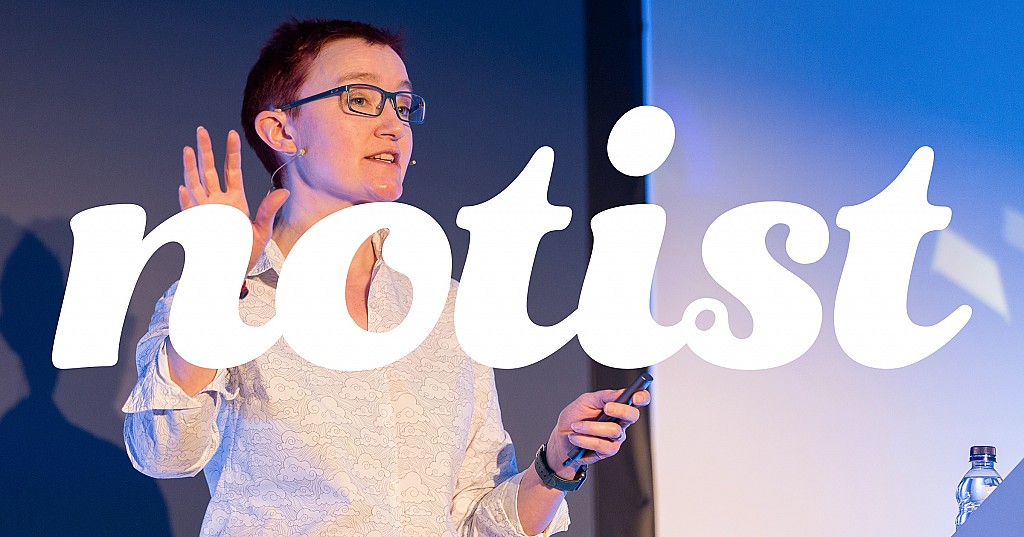Introducing Notist

There exists a whole class of web sites for being “your home for x” as-a-service, where x is something you’ve created and want to share with others. If it’s code, there’s GitHub. For photos, you have Instagram and poor old moth-eaten Flickr. Music goes on Soundcloud, and if you’re the active type you can share workouts on Strava.
If you ever do any public speaking, you will have information from your presentation you’d like to make available afterwards. If you speak fairly regularly, you might want to keep an upcoming schedule of future engagements, and an archive of past conferences.
To help with that, we’re making a web site! It’s called Notist.
So is this another slide sharing site?
I’m glad I asked! There are, of course, already lots of options for sharing your slides after a presentation. There are sites like SlideShare and SpeakerDeck that will fulfil the basic task of sharing a sequence of slides. But slides are only one type of output from a presentation, and while they’re a useful resource for attendees they don’t tell the full story.
Sharing slides is one feature of Notist, but it’s not the entire thing.
Is this like Lanyrd?
We really love Lanyrd, but no, this is something different. Whereas Lanyrd is (was?) all about events and the people attending them, Notist is focused on serving the person up on stage.
Notist is a site to help the speaker share with their audience, help them to promote events they’re at, and help them get more speaking gigs in the future by having a great portfolio to show.
When responding to a Call for Papers (CFP), speakers are often asked what speaking experience they have and where they’ve spoken in the past. Their Notist profile is the answer to that question.
What else can you share?
As well as slides, you can share links to resources mentioned in your presentation, add files such as PDFs, and if it’s a technical talk, embed code from services like Gist, CodePen or JS Bin.
If the conference publishes a video or audio recording, you can add that to your presentation too. If you wanted to record your own video of the presentation, there’s nothing to stop you doing that either.
As a public speaker, you should be able to assemble a full and complete set of resources for your audience to be able to reference into the future.
But that’s all stuff you’ve generated. Another important aspect to a presentation is the reaction of your audience to it. If there are complimentary tweets on Twitter, nice photos from the audience or the conference photographer, or perhaps someone creative has made some sketch notes or written up a review on their blog, you should able to collect all those together on the page too.
Notist has tools that hook into your social media accounts to help you find and select tweets, Instagram photos, and so on to build up a really rich picture of how your talk went across with the audience.
Why yet-another-service?
With Perch we did a pretty decent job of building software that anyone can run as part of their own website, so why not do that again? Truth is, even those who have their own websites and the skills to curate them often don’t have the time to sink into yet another project. Sometimes you just want something manage it for you.
While Rachel and I both speak at events for the web design and development industry, there are plenty of public speakers in a wide range of other industries who might find Notist useful. And they probably would rather use a service than install some software.
We do recognise how important it is to have ownership of your own data, and we’ve all seen sites shut down or stagnate without a good way of exporting data and recouping your time investment. We don’t want that to be the case for Notist, so we’ve built it to be exportable and shareable from the heart.
Any data that goes in can immediately be retrieved as JSON. This also means you can use Notist like an API to power parts of your own website too if you please. If you want to use our pages but advertise your own URLs, we’re going to offer the ability to point a CNAME record so that you can use your own domain. That gives you the opportunity to maintain those URLs even if we went away in the future.
Some of this will be free, but some of the cool stuff will need a subscription. That’s another way we’ll try and make sure Notist sticks around for you.
Woohoo!
So that’s Notist. We’ll be inviting testers in soon, but for now you can reserve your username by logging in with your GitHub account.